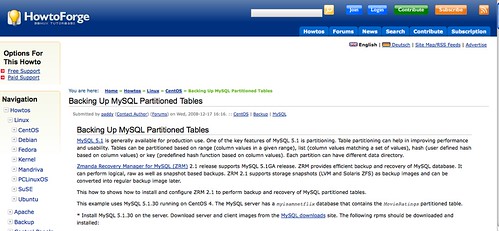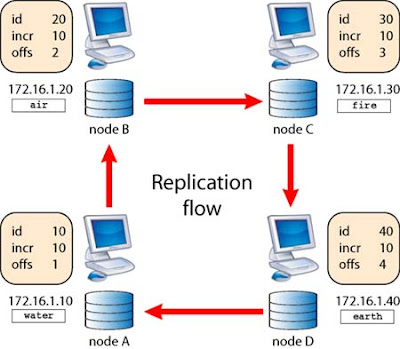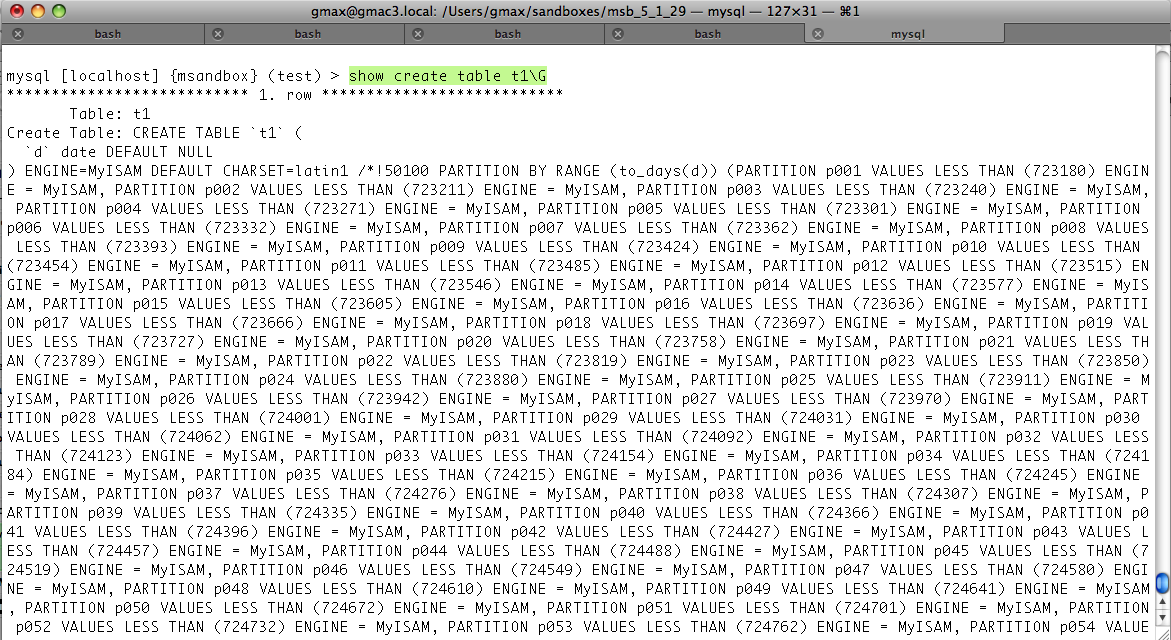
| I talked several times about partitioning usability. In my many tests of partitioning I found myself in need of generating list of partitions for a given range.
I made the Partition Helper (see code at the end of this post) to scratch this particular itch, i.e. making partitions reasonably quickly and without thinking too much.
|
The Partition Helper is a
Perl script that converts some simple options into lots of partitions.
The detailed
reference manual lists all the options and many examples.
Here, I would like to show just an example.
Say, you want to create partitions in table
blog_posts by monthly intervals on column
published. Given that you have data for the last two years, you use the partition helper like this:
./partitions_helper --table=blog_posts \
--column=published \
--interval=month \
--start=2007-01-01 \
--end=2009-01-01
ALTER TABLE blog_posts
PARTITION by range (to_date(published))
(
partition p001 VALUES LESS THAN (to_days('2007-01-01'))
, partition p002 VALUES LESS THAN (to_days('2007-02-01'))
, partition p003 VALUES LESS THAN (to_days('2007-03-01'))
, partition p004 VALUES LESS THAN (to_days('2007-04-01'))
, partition p005 VALUES LESS THAN (to_days('2007-05-01'))
, partition p006 VALUES LESS THAN (to_days('2007-06-01'))
, partition p007 VALUES LESS THAN (to_days('2007-07-01'))
, partition p008 VALUES LESS THAN (to_days('2007-08-01'))
, partition p009 VALUES LESS THAN (to_days('2007-09-01'))
, partition p010 VALUES LESS THAN (to_days('2007-10-01'))
, partition p011 VALUES LESS THAN (to_days('2007-11-01'))
, partition p012 VALUES LESS THAN (to_days('2007-12-01'))
, partition p013 VALUES LESS THAN (to_days('2008-01-01'))
, partition p014 VALUES LESS THAN (to_days('2008-02-01'))
, partition p015 VALUES LESS THAN (to_days('2008-03-01'))
, partition p016 VALUES LESS THAN (to_days('2008-04-01'))
, partition p017 VALUES LESS THAN (to_days('2008-05-01'))
, partition p018 VALUES LESS THAN (to_days('2008-06-01'))
, partition p019 VALUES LESS THAN (to_days('2008-07-01'))
, partition p020 VALUES LESS THAN (to_days('2008-08-01'))
, partition p021 VALUES LESS THAN (to_days('2008-09-01'))
, partition p022 VALUES LESS THAN (to_days('2008-10-01'))
, partition p023 VALUES LESS THAN (to_days('2008-11-01'))
, partition p024 VALUES LESS THAN (to_days('2008-12-01'))
, partition p025 VALUES LESS THAN (to_days('2009-01-01'))
);
The above command can be also expressed as
./partitions_helper --table=blog_posts --column=published --interval=month \
--start=2007-01-01 --partitions=25
Or you can shorten it, if you remember the small options:
./partitions_helper -t blog_posts -c published -i month -s 2007-01-01 -p 25
More options are available. You can see them using
./partitions_helper --help
Enjoy!
Update Here's the code to the Partition helper, published here after MySQL Forge was taken down.
#!/usr/bin/perl
# The MySQL Partitions helper
# Copyright (C) 2008, 2009 Giuseppe Maxia
#
# This program is free software; you can redistribute it and/or modify
# it under the terms of the GNU General Public License as published by
# the Free Software Foundation; version 2 of the License
#
# This program is distributed in the hope that it will be useful,
# but WITHOUT ANY WARRANTY; without even the implied warranty of
# MERCHANTABILITY or FITNESS FOR A PARTICULAR PURPOSE. See the
# GNU General Public License for more details.
#
# You should have received a copy of the GNU General Public License
# along with this program; if not, write to the Free Software
# Foundation, Inc., 51 Franklin St, Fifth Floor, Boston, MA 02110-1301 USA
#
# This program creates a ALTER TABLE statement to add or reorganize
# date based partitions for MySQL 5.1 or later
#
use strict;
use warnings;
# use diagnostics;
use English qw( ‐no_match_vars ) ;
use Getopt::Long qw(:config no_ignore_case );
use Data::Dumper;
my $VERSION = '1.0.4';
#
# Parse options are fully qualified options with descriptive help,
# parse string for the command line, and sort order for the help
#
my %parse_options = (
table => {
value => '',
parse => 't|table=s',
help => [
'The table being partitioned',
'(no default)'
],
so => 20,
},
column => {
value => '',
parse => 'c|column=s',
help => [
'The partitioning column',
'(no default)',
],
so => 30,
},
interval => {
value => 'month',
parse => 'i|interval=s',
help => [
'The interval between partitions',
'Accepted: "year", "month", "week", "day", or a number',
'(default: month) ',
],
so => 40,
},
partitions => {
value => 0,
parse => 'p|partitions=i',
help => [
'How many partitions to create',
'(default: 0) ',
],
so => 50,
},
first_partition => {
value => 1,
parse => 'first_partition=i',
help => [
'the first partition to create',
'(default: 1) ',
],
so => 60,
},
reorganize => {
value => '',
parse => 'reorganize=s',
help => [
'the partition(s) to reorganize',
'(default: none) '
],
so => 70,
},
start => {
value => '2001-01-01',
parse => 's|start=s',
help => [
'the minimum partitioning value',
'(default: 1 for numbers, 2001-01-01 for dates) '
],
so => 80,
},
end => {
value => '',
parse => 'e|end=s',
help => [
'The maximum partitioning value',
'Used unless --partitions is used',
'(no default) ',
],
so => 90,
},
function => {
value => '',
parse => 'f|function=s',
help => [
'The partitioning function to use in the "range" declaration',
'(default: to_days, unless --list is used) ',
],
so => 100,
},
list => {
value => 0,
parse => 'l|list',
help => [
'Use the COLUMNS feature (versions >= 5.5)',
'(default: no) ',
],
so => 110,
},
maxvalue => {
value => 0,
parse => 'x|maxvalue',
help => [
'Adds MAXVALUE as last partition',
'(default: disabled) ',
],
so => 115,
},
prefix => {
value => 'p',
parse => 'prefix=s',
help => [
'prefix for partition name',
'(default: p) ',
],
so => 120,
},
explain => {
value => 0,
parse => 'explain',
help => [
'show the current option values',
'(default: no) ',
],
so => 130,
},
version => {
value => 0,
parse => 'version',
help => [
'display the version',
'(default: none) ',
],
so => 400,
},
help => {
value => 0,
parse => 'h|help',
help => [
'display the help page',
'(default: no) ',
],
so => 500,
},
);
#
# convert parse options to simple options
#
my %options = map { $_ , $parse_options{$_}{'value'}} keys %parse_options;
#
# get the options from the command line
#
GetOptions (
map { $parse_options{$_}{parse}, \$options{$_} }
grep { $parse_options{$_}{parse}} keys %parse_options
) or get_help();
get_help() if $options{help};
if ($options{version}) {
print credits();
exit 0;
}
# print Dumper(\%options) ; exit;
my %valid_intervals = (
day => 1,
week => 1,
month => 1,
year => 1,
);
#
# start and end dates
#
my ($syear, $smonth, $sday) = ();
my ($eyear, $emonth, $eday) = ();
#
# deals with placeholder features
#
for my $op ( qw(operation) ) {
if ($options{$op}) {
die "option <$op> is not implemented yet\n";
}
}
#
# check that a table and column are given
#
unless ($options{table}) {
die "table name required\n";
}
unless ($options{column} or $options{reorganize} ) {
die "column name required\n";
}
#
# accept only one of --end or --partitions
#
if ($options{end} && $options{partitions}) {
die "too many quantifiers. Use EITHER '--partitions' OR '--end' \n";
}
#
# check that we parsed a valid interval
#
if ( $options{interval} =~ /^\d+$/) {
unless ($options{start} =~ /^\d+$/) {
$options{start} = 1;
}
if ($options{end}) {
unless ($options{end} =~ /^\d+$/) {
die "the end value must be a number\n";
}
if ($options{end} < $options{interval}) {
die "the end value must be bigger than the interval\n";
}
if ($options{end} <= $options{start}) {
die "the end value must be bigger than the start\n";
}
$options{partitions} = int( ($options{end} +1 - $options{start}) / $options{interval});
}
}
else {
unless (exists $valid_intervals{ $options{interval} } ) {
die "invalid interval specified: $options{interval}\n";
}
#
# for year, month, or week the function must be to_days
#
unless ($options{list}) {
$options{function} = 'to_days' unless $options{function};
}
#
# check the start date
#
if ( $options{start} =~ /(\d{4})[\-\.\/](\d+)[\-\.\/](\d+)/) {
($syear, $smonth, $sday) = ($1, $2, $3);
$smonth +=0;
$sday +=0;
#print "start $syear $smonth $sday\n";
}
else {
die "invalid date $options{start}\n";
}
#
# check the end date
#
if ($options{end}) {
if ( $options{end} =~ /(\d{4})[\-\.\/](\d+)[\-\.\/](\d+)/) {
($eyear, $emonth, $eday) = ($1, $2, $3);
$emonth +=0;
$eday +=0;
# print "end $eyear $emonth $eday\n";
}
else {
die "invalid date $options{end}\n";
}
if ($options{interval} eq 'year') {
$options{partitions} = $eyear - $syear +1;
}
elsif ($options{interval} eq 'month') {
my $months = (12 - $smonth)
+ ( ($eyear - $syear -1) * 12 )
+ $emonth + 1;
# print $months,$/;
$options{partitions} = $months;
}
elsif ($options{interval} eq 'week') {
$options{partitions} = weeks_between($syear, $smonth, $sday,
$eyear, $emonth, $eday);
}
elsif ($options{interval} eq 'day') {
$options{partitions} = days_between($syear, $smonth, $sday,
$eyear, $emonth, $eday);
}
}
}
#
# there must be a valid number of partitions
#
unless ($options{partitions} && ($options{partitions} =~ /^\d+$/) ) {
die "number of partitions required. Use EITHER '--partitions' OR '--end'\n";
}
if ($options{partitions} > 1024) {
die "too many partitions ($options{partitions}). Maximum allowed is 1024\n";
}
else {
print "# partitions: $options{partitions}\n";
}
#
# don't accept a function if COLUMS is being used
#
if ( $options{function} && $options{list} ) {
die "you must specify either list or function\n";
}
if ($options{explain}) {
show_options();
}
# print Dumper(\%options) ; exit;
# -----------------------------------------
# start building the ALTER TABLE statement
# -----------------------------------------
print "ALTER TABLE $options{table} \n";
if ($options{reorganize} ) {
print "REORGANIZE PARTITIONS $options{reorganize} INTO \n";
$options{prefix} = 'pr';
}
else {
print "PARTITION by range " ;
if ($options{function}) {
print "($options{function}(";
}
elsif ($options{list}) {
print "columns("
}
else {
print "("
}
print "$options{column}";
if ($options{function}) {
print ")";
}
print ")\n";
}
print "(\n";
make_partitions( $options{interval});
print ");\n";
# -----------------------------------------
# functions
# -----------------------------------------
sub make_partitions {
my ($interval) = @_;
my $partitions_done=0;
my $p_year = $syear;
my $p_month = $smonth;
my $p_day = $sday;
my $func_start = 'to_days('; #$options{function};
my $func_end = ")";
if ($options{list}) {
$func_start = "";
$func_end = "";
}
for my $part ($options{first_partition} ..
$options{first_partition} + $options{partitions} -1 ) {
if ($partitions_done) {
print ", ";
}
else {
print " "
}
$partitions_done++;
if ($interval =~ /^\d+$/) {
printf "partition %s%03d VALUES LESS THAN (%d)\n",
$options{prefix},
$partitions_done,
($options{start} + (($partitions_done - 1) * $interval)) + $interval;
}
else {
printf "partition %s%03d VALUES LESS THAN (%s'%4d-%02d-%02d'%s)\n",
$options{prefix},
$partitions_done,
$func_start,
$p_year,
$p_month,
$p_day,
$func_end;
if ($interval eq 'day') {
($p_year,$p_month,$p_day) = next_day($p_year, $p_month, $p_day);
}
elsif ($interval eq 'week') {
($p_year,$p_month,$p_day) = next_week($p_year, $p_month, $p_day);
}
elsif ($interval eq 'month') {
($p_year,$p_month) = next_month($p_year, $p_month);
}
elsif ($interval eq 'year') {
($p_year,$p_month) = next_year($p_year, $p_month);
}
else {
die "unsupported interval\n";
}
}
}
if ($options{'maxvalue'}) {
printf ", partition %s%03d VALUES LESS THAN (MAXVALUE)\n",
$options{prefix},
++$partitions_done;
}
}
sub next_year {
my ($y, $m) = @_;
$y++;
return ($y, $m);
}
sub next_week {
my ($y, $m, $d) = @_;
for my $i (1 .. 7) {
($y, $m, $d) = next_day($y, $m, $d);
}
return ($y, $m, $d);
}
sub next_day {
my ($y, $m, $d) = @_;
$d++;
$m += 0;
my $last_day = days_in_month($y, $m);
if ($d > $last_day) {
$d = 1;
$m++;
}
if ($m > 12) {
$m = 1;
$y++;
}
return ($y, $m, $d);
}
sub is_leap_year {
my ($y) = @_;
if (($y % 400) == 0) {
return 1;
}
elsif (($y % 100) == 0) {
return 0;
}
elsif (($y % 4) == 0) {
return 1
}
return 0
}
sub days_in_month {
my ($y, $m) = @_;
$m = $m +0;
my %last_day = (
1 => 31,
2 => 28,
3 => 31,
4 => 30,
5 => 31,
6 => 30,
7 => 31,
8 => 31,
9 => 30,
10=> 31,
11=> 30,
12=> 31,
);
if (($m ==2) and (is_leap_year($y))) {
$last_day{2} = 29;
}
return $last_day{$m};
}
sub days_to_year_end {
my ($y, $m, $d) = @_;
my $days = days_in_month($y,$m) - $d +1 ;
for my $month ( $m +1 .. 12 ) {
$days += days_in_month($y, $month);
}
return $days;
}
sub months_between {
my ($syear, $smonth,
$eyear, $emonth) = @_;
my $months = (12 - $smonth)
+ ( ($eyear - $syear -1) * 12 )
+ $emonth + 1;
return $months;
}
sub days_between {
my ($syear, $smonth, $sday,
$eyear, $emonth, $eday) = @_;
# print "start $syear, $smonth, $sday\n end $eyear, $emonth, $eday\n";
my $days =0;
if ( sprintf ("%4d%2d%2d", $eyear, $emonth, $eday)
lt
sprintf("%4d%2d%2d", $syear, $smonth, $sday) )
{
die "start interval > end interval\n";
}
while ( ($syear < $eyear)
or ( ($syear == $eyear) and ($smonth < $emonth) )
or ( ($syear == $eyear) and ($smonth == $emonth) and ($sday < $eday) )
) {
if ($syear < $eyear) {
$days += days_to_year_end($syear, $smonth, $sday);
$syear++;
$smonth=1;
$sday=1;
}
elsif ($smonth < $emonth) {
$days += days_in_month($syear, $smonth) - $sday;
($syear, $smonth) = next_month($syear, $smonth);
$sday =1;
}
elsif ($sday < $eday) {
$days += $eday - $sday +1;
$sday = $eday;
}
}
return $days;
}
sub weeks_between {
my ($syear, $smonth, $sday,
$eyear, $emonth, $eday) = @_;
my $days = days_between ($syear, $smonth, $sday,
$eyear, $emonth, $eday);
# print $days, "\n"; exit;
return int ($days / 7) +1;
}
sub next_month {
my ($y, $m) = @_;
if ($m == 12) {
$m = 1;
$y++;
}
else {
$m++;
}
return ($y, $m);
}
sub get_help {
my ($msg) = @_;
if ($msg) {
warn "[***] $msg\n\n";
}
my $HELP_MSG = q{};
for my $op (
sort { $parse_options{$a}{so} <=> $parse_options{$b}{so} }
grep { $parse_options{$_}{parse}} keys %parse_options ) {
my $param = $parse_options{$op}{parse};
my $param_str = q{ };
my ($short, $long ) = $param =~ / (?: (\w) \| )? (\S+) /x;
if ($short) {
$param_str .= q{-} . $short . q{ };
}
$long =~ s/ = s \@? / = name/x;
$long =~ s/ = i / = number/x;
$param_str .= q{--} . $long;
$param_str .= (q{ } x (40 - length($param_str)) );
my $text_items = $parse_options{$op}{help};
for my $titem (@{$text_items}) {
$HELP_MSG .= $param_str . $titem . "\n";
$param_str = q{ } x 40;
}
if (@{$text_items} > 1) {
$HELP_MSG .= "\n";
}
# $HELP_MSG .= "\n";
}
print credits(),
"syntax: $PROGRAM_NAME [options] \n",
$HELP_MSG;
exit( $msg ? 1 : 0 );
}
sub credits {
my $CREDITS =
qq( The Partition Helper, version $VERSION\n)
. qq( This program creates a ALTER TABLE statement to add or reorganize\n )
. qq( partitions for MySQL 5.1 or later\n)
. qq( (C) 2008-2010 Giuseppe Maxia\n);
return $CREDITS;
}
sub show_options {
printf "# %-20s %-20s %s\n", 'options', 'default', 'value';
printf "# %-20s %-20s %s\n", '-' x 20, '-' x 20, '-' x 20;
for my $op ( sort { $parse_options{$a}{so} <=> $parse_options{$b}{so} }
keys %parse_options) {
my $v = $options{$op};
my $d = $parse_options{$op}{value};
printf "# %-20s %-20s %s\n",
$op,
'(' . (defined $d ? $d : '') . ')',
defined $v ? $v : '' ;
}
print '# ', '-' x 62, "\n";
}





































